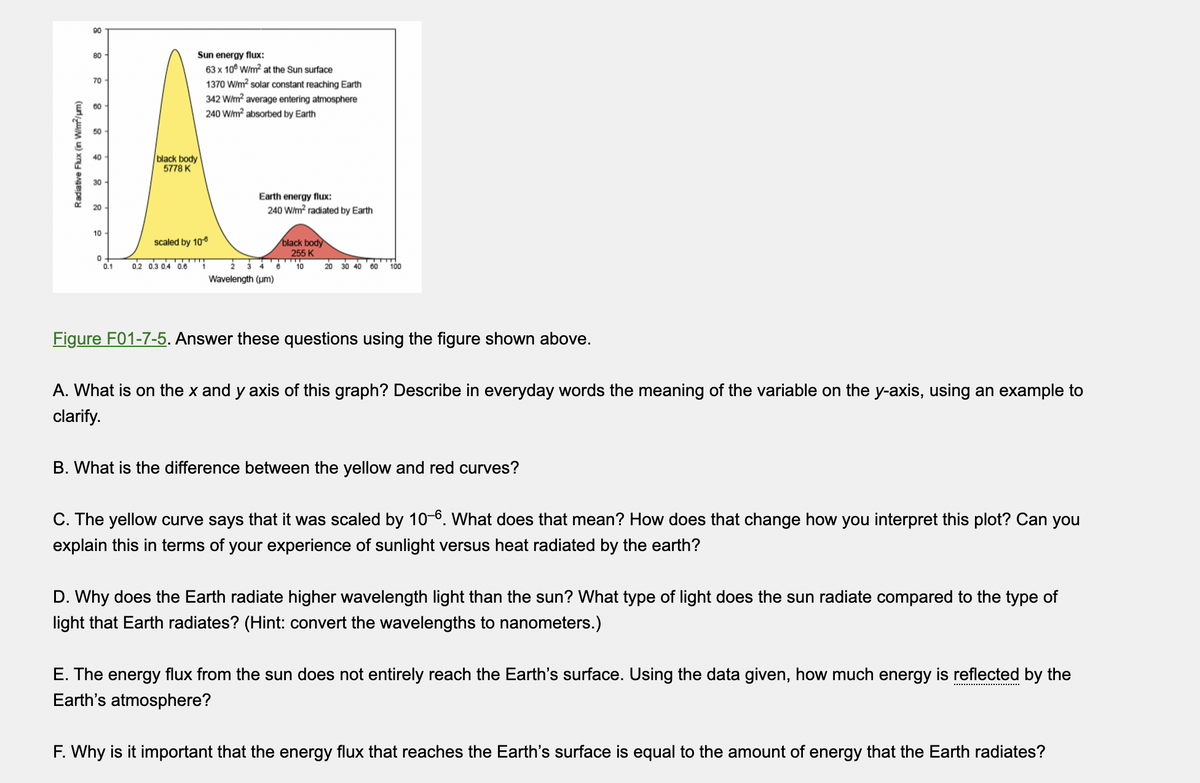A. What is on the x and y axis of this graph? Describe in everyday words the meaning of the variable on the y-axis, using an example to clarify. B. What is the difference between the yellow and red curves? C. The yellow curve says that it was scaled by 10-6. What does that mean? How does that change how you interpret this plot? Can you explain this in terms of your experience of sunlight versus heat radiated by the earth?
A. What is on the x and y axis of this graph? Describe in everyday words the meaning of the variable on the y-axis, using an example to clarify. B. What is the difference between the yellow and red curves? C. The yellow curve says that it was scaled by 10-6. What does that mean? How does that change how you interpret this plot? Can you explain this in terms of your experience of sunlight versus heat radiated by the earth?
Chemistry: The Molecular Science
5th Edition
ISBN:9781285199047
Author:John W. Moore, Conrad L. Stanitski
Publisher:John W. Moore, Conrad L. Stanitski
Chapter4: Energy And Chemical Reactions
Section: Chapter Questions
Problem 12QRT
Related questions
Question
from a to c please
thank you

Transcribed Image Text:90
80 -
Sun energy flux:
63 x 10° W/m? at the Sun surface
70
1370 W/m? solar constant reaching Earth
342 Wim? average entering atmosphere
240 W/m? absorbed by Earth
80
50
black body
5778 K
40
30
Earth energy flux:
20
240 W/m? radiated by Earth
10
black body
255 K
scaled by 10
0.1
0.2 0.3 0.4 0.6
10
20
30 40
60
100
Wavelength (um)
Figure F01-7-5. Answer these questions using the figure shown above.
A. What is on the x and y axis of this graph? Describe in everyday words the meaning of the variable on the y-axis, using an example to
clarify.
B. What is the difference between the yellow and red curves?
C. The yellow curve says that it was scaled by 10-6. What does that mean? How does that change how you interpret this plot? Can you
explain this in terms of your experience of sunlight versus heat radiated by the earth?
D. Why does the Earth radiate higher wavelength light than the sun? What type of light does the sun radiate compared to the type of
light that Earth radiates? (Hint: convert the wavelengths to nanometers.)
E. The energy flux from the sun does not entirely reach the Earth's surface. Using the data given, how much energy is reflected by the
Earth's atmosphere?
F. Why is it important that the energy flux that reaches the Earth's surface is equal to the amount of energy that the Earth radiates?
Radiative Flux (in Wim/um)
Expert Solution
This question has been solved!
Explore an expertly crafted, step-by-step solution for a thorough understanding of key concepts.
This is a popular solution!
Trending now
This is a popular solution!
Step by step
Solved in 2 steps

Knowledge Booster
Learn more about
Need a deep-dive on the concept behind this application? Look no further. Learn more about this topic, chemistry and related others by exploring similar questions and additional content below.Recommended textbooks for you

Chemistry: The Molecular Science
Chemistry
ISBN:
9781285199047
Author:
John W. Moore, Conrad L. Stanitski
Publisher:
Cengage Learning

Chemistry & Chemical Reactivity
Chemistry
ISBN:
9781337399074
Author:
John C. Kotz, Paul M. Treichel, John Townsend, David Treichel
Publisher:
Cengage Learning

Chemistry & Chemical Reactivity
Chemistry
ISBN:
9781133949640
Author:
John C. Kotz, Paul M. Treichel, John Townsend, David Treichel
Publisher:
Cengage Learning

Chemistry: The Molecular Science
Chemistry
ISBN:
9781285199047
Author:
John W. Moore, Conrad L. Stanitski
Publisher:
Cengage Learning

Chemistry & Chemical Reactivity
Chemistry
ISBN:
9781337399074
Author:
John C. Kotz, Paul M. Treichel, John Townsend, David Treichel
Publisher:
Cengage Learning

Chemistry & Chemical Reactivity
Chemistry
ISBN:
9781133949640
Author:
John C. Kotz, Paul M. Treichel, John Townsend, David Treichel
Publisher:
Cengage Learning


Chemistry: Principles and Practice
Chemistry
ISBN:
9780534420123
Author:
Daniel L. Reger, Scott R. Goode, David W. Ball, Edward Mercer
Publisher:
Cengage Learning

Chemistry for Engineering Students
Chemistry
ISBN:
9781337398909
Author:
Lawrence S. Brown, Tom Holme
Publisher:
Cengage Learning